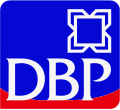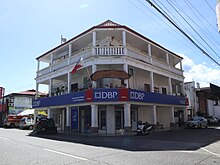| This article needs additional citations for verification. Please help improve this article by adding citations to reliable sources. Unsourced material may be challenged and removed. Find sources: "Development Bank of the Philippines" – news · newspapers · books · scholar · JSTOR (May 2017) (Learn how and when to remove this message) |
 | |
 DBP Head Office at Gil Puyat Avenue corner Makati Avenue, Makati DBP Head Office at Gil Puyat Avenue corner Makati Avenue, Makati | |
| Company type | Government financial institution |
|---|---|
| Industry | Development finance |
| Founded | January 2, 1947; 77 years ago (1947-01-02) in Manila, Philippines |
| Headquarters | Makati, Philippines |
| Key people | |
| Services | Financial Services |
| Net income | ₱5.60 billion (2019) |
| Total assets | ₱1.04 trillion (2020) |
| Website | www |
The Development Bank of the Philippines (DBP) is a state-owned development bank headquartered in Makati, Philippines. It is primarily tasked to provide banking services to cater to the needs of agricultural and industrial enterprises. It has 146 branches including 14 branch lite units.
It was established after World War II in 1947 on the government's effort through its mandate to rebuild the country's war-torn infrastructure. It focuses on four major areas of financing — infrastructure and logistics, social services, small and medium enterprises, and the environment.
As of 2023, it was the eighth-largest bank in the Philippines in terms of assets. DBP is also the second-largest and one of the state-owned and controlled banks along with Land Bank of the Philippines (LBP), Overseas Filipino Bank (OFW Bank), and Al-Amanah Islamic Bank. As a GOCC (Government Operated and Controlled Corporation), DBP is required to declare and remit at least half of its annual net earnings to the National Government.
History


DBP's history can be traced back to the Commonwealth Era. In 1935, the National Loan and Investment Board (NLIB) was created to coordinate and manage various government trust funds such as the Postal Savings Fund and the Teacher's Retirement Fund.
In 1939, the NLIB was abolished and its functions were transferred to a new body, the Agricultural and Industrial Bank (AIB). AIB continued operations until the outbreak of World War II.
In 1947, the government created the Rehabilitation Finance Corporation (RFC) under Republic Act No. 85 which absorbed the assets and took over the functions of the AIB. The RFC provided credit facilities for the development of agriculture, commerce and industry and the reconstruction of properties damaged by the war.
In 1958, the RFC was reorganized into the modern-day DBP. The change in corporate name marked the shift from rehabilitation to broader activities.
With an initial capital of ₱500-million, DBP set to work on expanding its facilities and operations to accelerate efforts towards promoting national economic development. The bank established a nationwide branch network and tapped local and foreign resources to complement its capital. It also borrowed money directly from international finance institutions.
In the late 1970s up to the early 1980s, however, its viability was undermined by numerous non-performing accounts.
In 1986, President Corazon Aquino issued Executive Order No. 81, which reorganized the bank and gave it a new charter. All non-performing assets and liabilities were subsequently transferred to the government. DBP undertook an institutional strengthening program, including a thorough revision of its credit process, as well as employee training programs towards the intensive implementation of its new lending thrusts. DBP likewise reopened its lending windows for housing, agriculture and SMEs.
In 1995, DBP was granted an expanded banking license and attained universal banking status.
President Fidel Ramos signed Republic Act No. 8523 in 1998, amending DBP's 1986 charter. Among the major provisions incorporated in the new DBP charter were the increase of authorized capital stock from ₱5-billion to ₱35-billion, and the creation of the position of President and CEO.
In February 2016, President Benigno Aquino III approved the merger of DBP with state-owned Land Bank of the Philippines, pending approval from the Bangko Sentral ng Pilipinas (BSP) and written consent of the Philippine Deposit Insurance Corporation. A few months later in September under the administration of newly-elected Rodrigo Duterte, such had been cancelled for implementation by the Governance Commission for GOCCs (GCG). By 2023, two presidents later under the administration of Ferdinand "Bongbong" Marcos Jr., the idea of such merger is again on the cards, with target completion around middle of 2024. However, as of early October 2023, the BSP says that they still haven't formally received an application for the merger. Finance Secretary Ralph Recto later announced in February 2024 that the proposed DBP-Landbank merger is no longer pursued.
Organization
The affairs and business of DBP are directed and its properties managed and preserved, and its corporate powers exercised by a board of directors consisting of nine members, all appointed by the President of the Philippines. The term of office of the chairman, president and the members of the board of directors are for a period of one year or until such time as their successors are appointed.
The chairman of the board is appointed by the President of the Philippines from among the members of the board: provided, that the positions of chairman of the board and president of DBP are not to be held by the same person.
The DBP chairman presides at meetings of the board, while the president of the bank serves as vice-chairman of the board, and as such, assists the chairman and acts in his stead in case of absence or incapacity.
The chief executive officer of DBP is the president, who is elected by the board of directors from among themselves with the advice and consent of the President of the Philippines. The DBP president shall, among other powers and duties, execute, carry out and administer the policies, measures, orders and resolutions approved by the board; direct and supervise the operation and administration of the bank; and exercise such other powers and perform such other functions or duties as may be assigned to him by law or by the board from time to time.
The DBP board of directors provides for an organization and staff of officers and employees of the bank and upon recommendation of the DBP president, fix their remuneration and other emoluments. All positions in the bank are governed by the compensation, position classification system and qualification standards approved by the DBP board of directors based on a comprehensive job analysis of actual duties and responsibilities.
Key officials
The key officials of the bank include:
- Philip G. Lo – Chairman
- Michael O. de Jesus – President and Chief Executive Officer
- Roberto V. Antonio – Director
- Emmeline C. David – Director
- Wilma T. Eisma- Director
- Victor Alfonso A. Limlingan – Director
- Jaime Z. Paz – Director
Subsidiaries
DBP subsidiaries and affiliates include:
- Al-Amanah Islamic Investment Bank of the Philippines
- DBP Leasing Corporation
- DBP Data Center, Inc.
- DBP Management Corporation
See also
- List of banks in the Philippines
- Land Bank of the Philippines
- BancNet
- List of national development banks
References
- "DBP Board of Directors / Management". DBP Website. January 23, 2023. Retrieved January 23, 2023.
- "DBP Annual Report" (PDF) (Press release). Retrieved February 2, 2021.
- DBP breaches trillion peso asset mark; loans rise 19 percent. Retrieved December 7, 2021
- "About DBP". Retrieved September 27, 2022.
- "DBP branch in Cagayan de Oro moves to a more strategic location". DPB. Retrieved June 14, 2024.
- "Profile". Development Bank of the Philippines. Retrieved April 16, 2019.
- "Ranking as to Total Assets". bsp.gov.ph. March 31, 2023.
- "DBP 2018 net income hits P5.72-billion". Development Bank of the Philippines. April 5, 2019. Retrieved April 16, 2019.
- "Commonwealth Act No. 7". Official Gazette of the Republic of the Philippines. December 31, 1935. Archived from the original on August 3, 2023. Retrieved August 3, 2023.
- "Commonwealth Act No. 552". Senate Legislative Digital Resource. Senate of the Philippines. May 26, 1940. Archived from the original on August 3, 2023. Retrieved August 3, 2023.
- "Republic Act No. 85". Supreme Court E-Library. Supreme Court of the Philippines. October 29, 1946. Archived from the original on September 2, 2022. Retrieved August 3, 2023.
- "Republic Act No. 2081". Supreme Court E-Library. Supreme Court of the Philippines. June 14, 1958. Archived from the original on September 2, 2022. Retrieved August 3, 2023.
- "Executive Order No. 81, s. 1986 | GOVPH". Official Gazette of the Republic of the Philippines. December 3, 1986. Retrieved April 16, 2019.
- "Republic Act No. 8523". Official Gazette of the Republic of the Philippines. February 14, 1998. Archived from the original on August 3, 2023. Retrieved August 3, 2023.
- Vera, Ben O. de. "Duterte administration stops DBP-Land Bank merger". Philippine Daily Inquirer. Retrieved April 16, 2019.
- Pascual, Jekki. "DOF eyes completion of DBP-Landbank merger by mid-2024". ABS-CBN News Online. Retrieved November 10, 2023.
- Vicencio, Lady. "No application yet for proposed Landbank-DBP merger: BSP". ABS-CBN News Online. Retrieved November 10, 2023.
- Cigaral, Ian Nicolas (February 14, 2024). "It's official: No more DBP-Landbank merger". Philippine Daily Inquirer. Retrieved May 25, 2024.
- "Board of Directors / Management". Development Bank of the Philippines. Retrieved September 27, 2022.
External links
- Official website
 Media related to Development Bank of the Philippines at Wikimedia Commons
Media related to Development Bank of the Philippines at Wikimedia Commons
| Bangko Sentral ng Pilipinas | |
| Universal banks | |
| Government banks | |
| Commercial banks | |
| Thrift banks | |
| Digital banks | |
| Other banks | |
| Defunct |
|
| Makati Central Business District | |||||||
|---|---|---|---|---|---|---|---|
| Towers | |||||||
| Ayala Center | |||||||
| Other landmarks | |||||||
| Education | |||||||
| Transportation |
| ||||||
| Italics denote buildings under construction or planned. | |||||||